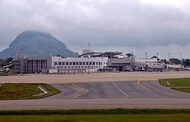A fire on an empty Boeing Co. Dreamliner at London’s Heathrow Airport would have posed a serious risk to the Ethiopian Airlines Enterprise jet had it occurred during a flight, the official probe into the incident said.
Cabin crew would have struggled to isolate and extinguish the blaze in the 787’s emergency locater transmitter, Britain’s Air Accidents Investigation Branch said Wednesday. Boeing’s own models show the 2013 fire could have caused “depressurization” of the passenger cabin had it occurred at altitude, though the plane would have retained its integrity, the agency added.
A short-circuit caused by crossed wires ignited a lithium battery in the transmitter, with resin in the jet’s composite hull fueling the flames, the AAIB said, confirming earlier findings. Honeywell International Inc., the transmitter’s maker, is redesigning the unit and taking other safety steps along with Boeing and the U.S. Federal Aviation Administration, it said.
Even Heathrow’s specialist fire services — alerted when control-tower staff noticed smoke rising from the parked 787 — found it tough to locate the origin of the blaze in the top of the interior fuselage toward the rear of the plane.
“Had this event occurred on an occupied aircraft the fire would not have been visible to either passengers or crew,” the 167-page AAIB report said. “Nor would any heat effect from the fire have been apparent to the occupants.”
Ceiling Panel
Tackling the fire in-flight would therefore have been “challenging,” with the circulation of smoke and fumes around the cabin disguising its position, according to the AAIB. Once located, crew would have to remove a ceiling panel, stand on an arm rest and aim an extinguisher at the source. The emergency transmitter’s independent batteries would also make it impossible to remove electrical power from the ignition source.
Fourteen safety recommendations have been issued as a result of the fire, the report said. Regulators in the U.S., Canada, Japan and Europe have requested that airlines check jets made by Boeing, Airbus Group SE and some other manufacturers for wiring faults in emergency beacons following the incident.
“We are committed to a process of continual improvement of our airplanes,” Chicago-based Boeing said in an e-mailed statement, adding that changes need to be reviewed with “great care” to avoid unintended consequences. “We are confident the 787 is safe and we stand behind its overall integrity.”
Fuselage Damage
Honeywell said that since 2013 it has worked closely with government agencies to issue inspection notices for all affected emergency locater transmitters, and updated the design.
“Honeywell is committed to the safety of all its products,” spokesman Steven Brecken said in an e-mail.
An area of fuselage measuring 9.5 square meters (102 square feet) was damaged in the fire, which also destroyed carbon-fiber insulation blankets designed to minimize heat loss and suppress noise. No one was injured.
The world’s first composite-plastic commercial airliner, the 787 was grounded for three months the same year as the Heathrow incident amid concern over fires involving its main batteries. The model, named the Dreamliner by Boeing, has won more than 1,000 orders by offering lower fuel consumption.













